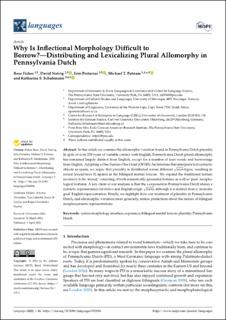| dc.contributor.author | Fisher, Rose | |
| dc.contributor.author | Natvig, David Albert | |
| dc.contributor.author | Pretorius, Erin | |
| dc.contributor.author | Putnam, Michael T. | |
| dc.contributor.author | Schuhmann, Katharina S. | |
| dc.date.accessioned | 2023-01-26T12:57:35Z | |
| dc.date.available | 2023-01-26T12:57:35Z | |
| dc.date.created | 2022-04-02T09:18:19Z | |
| dc.date.issued | 2022 | |
| dc.identifier.citation | Fisher, R., Natvig, D., Pretorius, E., Putnam, M. T., & Schuhmann, K. S. (2022). Why is inflectional morphology difficult to borrow?—Distributing and lexicalizing plural allomorphy in Pennsylvania Dutch. Languages, 7(2), 86. | en_US |
| dc.identifier.issn | 2226-471X | |
| dc.identifier.uri | https://hdl.handle.net/11250/3046621 | |
| dc.description.abstract | In this article we examine the allomorphic variation found in Pennsylvania Dutch plurality. In spite of over 250 years of variable contact with English, Pennsylvania Dutch plural allomorphy has remained largely distinct from English, except for a number of loan words and borrowings from English. Adopting a One Feature-One Head (OFOH) Architecture that interprets licit syntactic objects as spans, we argue that plurality is distributed across different √root-types, resulting in stored lexical-trees (L-spans) in the bilingual mental lexicon. We expand the traditional feature inventory to be ‘mixed,’ consisting of both semantically-grounded features as well as ‘pure’ morphological features. A key claim of our analysis is that the s-exponent in Pennsylvania Dutch shares a syntactic representation for native and English-origin √roots, although it is distinct from a ‘monolingual’ English representation. Finally, we highlight how our treatment of plurality in Pennsylvania Dutch, and allomorphic variation more generally, makes predictions about the nature of bilingual morphosyntactic representations. | en_US |
| dc.language.iso | eng | en_US |
| dc.publisher | MDPI | en_US |
| dc.rights | Navngivelse 4.0 Internasjonal | * |
| dc.rights.uri | http://creativecommons.org/licenses/by/4.0/deed.no | * |
| dc.title | Why Is Inflectional Morphology Difficult to Borrow?—Distributing and Lexicalizing Plural Allomorphy in Pennsylvania Dutch | en_US |
| dc.title.alternative | Why Is Inflectional Morphology Difficult to Borrow?—Distributing and Lexicalizing Plural Allomorphy in Pennsylvania Dutch | en_US |
| dc.type | Peer reviewed | en_US |
| dc.type | Journal article | en_US |
| dc.description.version | publishedVersion | en_US |
| dc.rights.holder | The author | en_US |
| dc.subject.nsi | VDP::Humaniora: 000 | en_US |
| dc.source.volume | 7 | en_US |
| dc.source.journal | Languages | en_US |
| dc.source.issue | 2 | en_US |
| dc.identifier.doi | 10.3390/languages7020086 | |
| dc.identifier.cristin | 2014767 | |
| cristin.ispublished | true | |
| cristin.fulltext | original | |
| cristin.qualitycode | 1 | |

